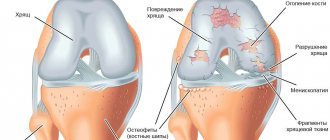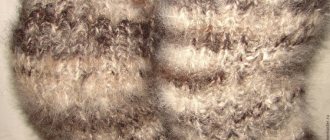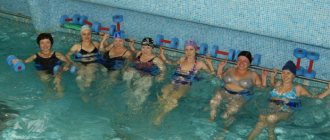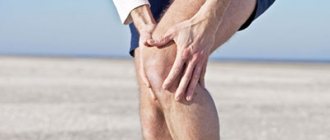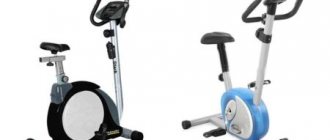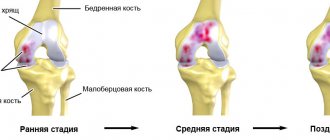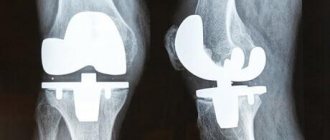Magnetotherapy (16) Infrared and phototherapy (10) Vibroacoustic therapy (6) Laser therapy (4) Quantum therapy (2) Thermotherapy (3) Electrophoresis and Galvanization (5) Electrical stimulation (3)
Magnetic therapy on the knee joint is one of the most effective methods of treating arthrosis. The essence of the technique is the effect of a magnetic field of different characteristics on all types of tissue. Magnetic therapy for arthrosis of the knee joint helps to achieve almost instant results.
The effectiveness of magnetic therapy on the knee joint:
- return of joint mobility;
- relieving inflammation;
- muscle relaxation;
- improvement of vascular tone;
- stimulation of blood circulation;
- improvement of blood properties.
The average time for treating arthrosis with magnets is 15-20 procedures, depending on the severity of the disease.
Magnetic therapy of the knee joint, indications:
- swelling of the knee;
- inflammatory processes;
- difficulty moving;
- tissue atrophy;
- lack of results from medication.
The effectiveness of magnet treatment depends on the correct implementation of the therapy.
It is important to exclude all contraindications. Magnetic therapy of the knee joint, contraindications:
- cancer;
- bleeding and tendency to it;
- heart pathologies;
- ulcerative or purulent abscesses, etc.
The patient should learn about contraindications and treatment methods at a preliminary consultation with a doctor.
In magnetic therapy of the knee joint, reviews from specialists and patients indicate the effectiveness and safety of this technique. Magnetic therapy for arthrosis can be carried out in a physical therapy room using stationary devices, or at home using portable magnetic therapy devices.
Magnetic therapy devices for the treatment of arthrosis of the knee joint
[td]
How does the procedure work?
- The patient lies down on the couch or sits on a stool (depending on the area being treated).
- The doctor installs 1 or 2 active inductors. In cases where two inductors operate simultaneously, a distance of at least 5 centimeters is left between them. Fastening is done by contact or with a gap of 0.5–1.5 centimeters.
Magnetophone elastic applicators are installed contact-wise and secured with bandages-fixers so that the contact is not broken, while maintaining comfort for the patient. The first session lasts no more than 5 minutes. The duration of the following sessions averages from 15 to 20 minutes. The course of therapy consists of 20 sessions conducted daily, without breaks. The duration of the procedure and the intensity of the impact are set and adjusted by the doctor. After the end of the session, the patient is usually recommended to refrain from going outside for a while (several minutes) and to refuse intense physical activity. Magnetic therapy has become widespread as a manipulation carried out for therapeutic and rehabilitation purposes.
The Scandinavian Health Center offers magnetic therapy services.
Our clinic has a wide range of domestically produced devices. BIOMAG device (Czech Republic) for 3D magnetic therapy (volumetric). Low frequency vibration magnetic therapy (Magneto QS, Italy). The center’s doctors are ready to provide qualified advice on all issues of interest to patients.
How does the MBST technique work?
View all
MBST therapy foreign practice
Treatment of Osteoporosis using MBST method
Effect of MBST therapy on cartilage tissue
Treatment of the hip joint with MBST therapy allows you to achieve the following effects:
- improving the elasticity, density and thickness of articular cartilage
- removal of edema
- restoration of bone density
- improving blood supply to bone tissue
This means that joint pain goes away, the range of motion in the joints and gait improves and is restored, as the cause of the disease is eliminated.
Timeframe for onset of effect:
depend on the depth and duration of the destructive process, the severity of the pain syndrome. A primary analgesic effect from moderate to pronounced can be observed by the end of the course of treatment in 75% of patients; within 3-6 months it can be of a changing nature with a constant tendency to improve. In 50% of patients, a mild exacerbation is observed, which can occur during the 2-4th procedure and end by the 5th-7th procedure. Clearly visible MRI dynamics in cartilage and bone tissues are expected from 6 to 9 months after completion of the course of treatment.
Performance criteria:
A study conducted in 2013, which analyzed the results of treatment of coxarthrosis in 673 patients, showed the high effectiveness of MBST therapy in relieving pain in the hip joint and improving function by 40-70% of the initial level.
Currently, a mandatory condition for the use of one or another physiotherapeutic method of treatment and rehabilitation in clinical practice is the presence of an evidence base in the form of previously conducted clinical studies that confirmed the effectiveness of this method using objective diagnostic methods [1].
The purpose of this article is to provide all interested clinical specialists with information about currently proven effective methods of treating patients with joint diseases using magnetic fields of various physical characteristics. This makes it possible to improve the effectiveness of complex treatment of patients with rheumatological and orthopedic problems using magnetic therapy (MT) methods, increase the level of their physical and social functioning during the rehabilitation process, prevent complications in the chronic course of the disease, and improve the quality of life of patients. To select an adequate physical method of treating a patient, it seems extremely important to analyze the available information on the effectiveness of various MT techniques.
Low-frequency MT is widely used in clinical practice both in the treatment and rehabilitation of patients after injuries, operations and vascular accidents. The mechanisms of action of this traditional physiotherapeutic method are quite well studied. A wide range of biotropic parameters makes it possible to change the characteristics of the magnetic field and cause various physiological effects in organs and tissues, which served as a rationale for the inclusion of MT in the complex treatment of degenerative-dystrophic and inflammatory diseases. The action of MT on the human body is based on primary physical and chemical processes associated with changes in the conformation and orientation of macromolecules, the rate of biochemical reactions and hydration of ions, the structure of water, an increase in the activity of metal-containing enzymes, etc. Under the influence of magnetic induction in biological tissues occurs action potential and electric currents of varying densities are formed. These induced low-frequency electric fields cause the movement of ions located near the charged surface of the membranes, which significantly affects bioelectrical and diffusion processes. Under the influence of low-frequency magnetic fields, the speed of action potentials along nerve conductors increases and their excitability increases. The primary interaction of the magnetic field with biological objects and the absorption of electromagnetic energy determine the physiological and therapeutic effects of MT [2].
MT is used in the complex treatment of patients with various joint diseases. Its anti-edematous, trophic, anti-inflammatory, and analgesic effects have been proven. Nevertheless, at present, issues of magnetobiology and MT contain many controversial and unresolved issues. Particularly acute in modern medicine are the issues of proving the effectiveness of a particular treatment method, and therefore the analysis and synthesis of scientific publications containing objective data on the results of randomized, placebo-controlled studies devoted to identifying the therapeutic possibilities of MT are highly relevant.
A fairly large number of studies have been conducted to evaluate the therapeutic effectiveness of MT in the treatment of patients with joint diseases. Thus, according to the results of a prospective, randomized, placebo-controlled, double-blind study conducted in clinics in Moscow and Kazan, it was found that in patients with gonarthrosis (GA) treated with a pulsed magnetic field (PMF) with an induction of 20 mT and a frequency of 6, 24 Hz, more significant positive dynamics of clinical symptoms were revealed, according to the EQ-5D (Euro-Quality of Life) questionnaire, as well as a decrease in joint volume compared to patients receiving placebo effects. Moreover, in the main group ( n
=75) a decrease in the “pain and discomfort” indicator by 57.3% was obtained, while in the placebo group (
n
=95) it was only by 37.9%. At the same time, no significant changes were detected in such functional indicators as “angle of flexion and extension of the affected joint”, “walking short distances” [3].
According to the results of a prospective, randomized, placebo-controlled, double-blind study (75 patients with HA), it was found that low-frequency MT for 6 weeks caused more significant changes in clinical indicators on the WOMAC scale (Western Ontario and McMaster Universities Arthrose index - severity rating scale). osteoarthritis) and EQ-5D in contrast to the placebo group. Thus, after MT the data on the WOMAC scale were: total score - p
=0.018, pain -
p
=0.065, disability -
p
=0.019, on the EQ-5D scale -
p
=0.001. No statistically significant changes were detected in the control group. The authors of the publication conclude that further research is necessary to identify the effectiveness of MT using different parameters and types of magnetic fields, differentiated treatment protocols on different patient populations [4].
The effectiveness of pulsed electromagnetic fields in the treatment of osteoarthritis (OA) is also evidenced by data from a meta-analysis of 9 randomized clinical trials (RCTs), including 483 patients with HA; favorable effects on the clinical manifestations of HA were revealed (weighted mean difference (WMD) 0.4; 95 % confidence interval (CI) 0.05—0.8; p
=0.029) and the level of household activity of such patients (HRV 0.8; 95% CI 0.2-1.4;
p
=0.014). The analyzed studies used different MT protocols, but no statistically significant differences in treatment effectiveness were identified [5].
Two systematic reviews provide compelling evidence of the analgesic effect of UTIs, which reduces locomotor dysfunction in patients with OA [6, 7]. Similar conclusions are drawn from the results of RCTs that proved significant benefits in the group of patients with OA who received BMI compared to the placebo group [8, 9].
A randomized, double-blind study in patients with knee OA showed a decrease in pain and an increase in joint mobility under the influence of a course of MT with an induction of 105 mT, a frequency of 8 Hz, and an exposure of 5 minutes. The procedures were carried out over 18 days [10].
Along with the improvement of clinical symptoms and locomotor function of the knee joints, some studies have shown an improvement in blood circulation under the influence of a magnetic field (MF) with an induction of 2 to 10 mT [11].
A number of authors propose thermographic research as one of the objective criteria for the effectiveness of MT. Thus, in a double-blind, placebo-controlled study in 57 patients with GA, along with differences in the clinical picture of the disease, more pronounced positive dynamics were established according to thermography data in patients who received UTI effects against the background of basic drug treatment. Thus, in the main group, the decrease in skin temperature in the area of the affected joints during a course of treatment with MT was 2 °C, while in the control group it was significantly less (0.8 °C) [12].
The effectiveness of MT was also shown in patients with primary and post-traumatic coxarthrosis in an open RCT ( n
=102). In patients of the main group who received low-frequency pulsed MT procedures against the background of basic treatment (taking meloxicam at a dose of 15 mg/day and therapeutic exercises), more pronounced positive dynamics were revealed on the visual analogue scale and the Lequesne index, while the analgesic effect persisted for 30 days after completing a course consisting of 15 procedures [13].
Attention should be paid to the fact that a number of foreign studies have shown a fairly high efficiency of small induction MP, while the procedures were carried out over a long course. Thus, 1 high-quality RCT in patients with OA showed a significant difference in the study results in the study and control groups. When assessed on 6 clinical parameters (general pain; difficulty with daily activities; worst discomfort in the past week; pain caused by ADLs; pain on movement and tenderness) differences were found to be 4-fold. Methodology M.T. differed in a small induction - 0.2 mT, frequency 30 Hz. The procedures were carried out for 1 month for 30 minutes [14].
One of the most important criteria for the effectiveness of MT is the quality of life of patients with OA. High-quality RCTs showed significant differences in the study and control groups in the results of the WOMAC scale, visual analogue scale and quality of life assessment using the EQ-5D questionnaire. The technique was also distinguished by low induction (0.05 mT) and low frequencies (3 and 7.5 Hz) [15].
It seems important that against the background of the therapeutic effect of MP in patients with OA, the need for taking non-steroidal anti-inflammatory drugs and analgesics decreased. This was shown, in particular, in a randomized, placebo-controlled study in which 83 patients with GA took part. In the main group, patients received low-induction effects for 2 hours a day for 6 weeks [16].
A review of 9 RCTs examining the effectiveness of MTX in 636 patients with OA found that MTX reduced pain severity, but did not significantly change the quality of life of patients [17]. At the same time, many researchers note a statistically significant improvement in the indicators of medical and psychological testing in patients with rheumatoid arthritis and OA after a course of general MT [18, 19].
Foreign sources contain references to 2 RCTs, the purpose of which was to study the effectiveness of BMI in osteochondrosis of the cervical spine [20, 21]. The results obtained convincingly indicate a decrease in pain and muscle spasms after a course of exposure to magnetic fields.
There are few RCTs devoted to identifying the effectiveness of MT in post-traumatic tendonitis [22, 23], chronic epicondylitis [24], temporomandibular syndrome [25], and osteoporosis [26]. High-quality RCTs have proven a significant improvement in bone tissue metabolism (based on the level of biochemical markers) and joint function under the influence of MT (magnetic induction value 4 mT, frequency 30 Hz, exposure 60 min) in patients with osteoporosis due to hemophilia A [27] . It should be noted that in domestic physiotherapy, hemophilia is an absolute contraindication for the prescription of any physical influence, including MT.
In an RCT of 28 patients with osteonecrosis of the knee joint, it was found that exposure to an electromagnetic field with an induction of 1.5 mT and a frequency of 75 Hz with a 6-hour exposure for a long time (up to 3 months) helped reduce pain and improve the functional state of the knee joints, as well as stimulation of osteogenic activity of osteoblasts [28].
Studies were conducted in patients with unstable hip joint endoprostheses who received long-term low-intensity magnetic influences for 6 months. Impact of M.P. decreased the Harris scale scores by 6 times compared to the placebo group, which made it possible to delay joint revision [29].
In another RCT, the authors showed that in patients who underwent total knee arthroplasty, anti-edematous, anti-inflammatory effects of MP with an induction of 1.5 mT were detected, which allows accelerating the time of functional recovery of patients after surgery [30].
The anti-inflammatory and analgesic effects of MT have been confirmed in patients with patellofemoral pain syndrome. MP parameters were characterized by a low induction of 1.5 mT, a frequency of 75 Hz, and large exposures were used - 4 hours per day for 6 weeks [31].
Mixed results have been obtained from studies examining the clinical effectiveness of constant magnetic field (CMF). A meta-analysis, taking into account the results of the use of PMP for pain relief according to 21 RCTs (15 of them of good quality), concluded that the use of MT for pain syndromes associated not only with inflammatory diseases of the musculoskeletal system and fibromyalgia, but also with neuropathies, as well as in the postoperative period [32].
Another RCT with double-blind control studied the effectiveness of PMP with different induction in patients with chronic lumbar radicular pain. The primary endpoint of the study was mean daily leg pain scores (scale 0–10). Significant differences in the level of pain were established depending on the level of magnetic field intensity. Better results were obtained with a magnetic induction value of 20 mT compared to 5 mT. Within 5 weeks, there was a gradual decrease in pain in 86% of cases [33]. Other authors come to similar conclusions [34].
The use of PMP (magnetic insoles) for a shorter period of time (8 weeks, 4 hours per day) did not cause significant changes in pain in the lower extremities according to a moderate quality RCT [35]. Also, in a placebo-controlled RCT in patients with fibromyalgia for 6 months, there were no differences in the severity of pain compared with the placebo group [36].
At the same time, in another multicenter (48 centers) high-quality RCT, when studying the effect of PMP on pain syndrome (375 subjects with diabetic polyneuropathy II-III degrees), it was found that constant wearing of magnetic insoles for 3-4 months with induction 45 mT significantly reduces the burning sensation ( p<
0.05), numbness and tingling (
p
<0.05), as well as pain in the leg (
p
<0.05).
Moreover, the identified significant differences also concerned patients with initial severe pain, in whom pain decreased no earlier than 4 months (main group - 41%, placebo group - 21%; p
<0.01), numbness and tingling (main group - 32 %, placebo group - 14%;
p
<0.01) [37].
These data from foreign researchers are of practical interest, since it is well known that PMP is significantly inferior in effectiveness to alternating magnetic fields, IMP, and in domestic physiotherapy this method is used extremely rarely for the treatment of pain syndromes. It should be noted that all the evidence provided for the effectiveness of PMP was obtained with long-term daily exposure to PMP and courses of at least 3 months.
MT occupies an important place in the rehabilitation of patients after joint surgery, since this method does not cause disruption of adaptation systems and is well tolerated even by weakened patients. A few RCTs have been devoted to identifying the effectiveness of BMI in patients with interbody fusion [38] and after arthroscopy [39]. 92% of patients who underwent spine surgery achieved a significant improvement after a course of BMI, while in the placebo group only 65% achieved a therapeutic effect ( p
<0.001). Conducting M.T. after arthroscopy requires additional evidence.
Two high-quality RCTs established the effectiveness of BMI in the rehabilitation of patients after long bone fractures [40, 41]. At the same time, for scaphoid fractures, there was no statistically significant difference in the severity of the treatment effect in patients receiving BMI and placebo [42].
A systematic review that analyzed the results of 4 RCTs (125 subjects with slow-healing or non-union long bone fractures) showed positive results of the use of BMI to accelerate osteoregeneration in 3 RCTs, in 1 case there was no convincing evidence of the effectiveness of MT [43].
The analysis of scientific publications allows us to draw a conclusion about the feasibility of using MT in arthrological practice. Foreign reviews most often analyze the results of a course of exposure to low-induction MP, with exposures of at least 30 minutes per procedure recommended [44-46]. In domestic physiotherapy, factual material has been accumulated confirming the effectiveness of MT in the range of 10-75 mT with an exposure of 15-20 minutes. The method of general MT, which uses an induction of 1.5-3 mT, is rarely used for joint diseases, although the experience accumulated by foreign researchers allows us to hope for the prospects for the development of this area of physiotherapy. It should be noted that the largest number of scientific publications that meet the requirements of evidence-based medicine are devoted to studying the effect of UTIs on clinical symptoms, the functional state of joints, microcirculation processes and inflammation. Thus, despite significant differences in methodological approaches, there is currently quite strong evidence of the effectiveness of the use of MT in patients with diseases and consequences of joint injuries based on the identified reduction in pain, increased daily activity, improved psycho-emotional state and generally improved quality of life .
Conflict of interest.
The authors declare that there is no conflict of interest related to the publication of this article.
The authors declare no conflicts of interest.
Information about authors
Konchugova T.V. - Doctor of Medical Sciences, Prof.; https://orcid.org/0000-0003-0991-8988; e-mail
Kulchitskaya D.B. - Doctor of Medical Sciences, Prof.; https://orcid.org/0000-0002-7785-9767; eLibrary SPIN: 2674-6371; e-mail
Ivanov A.V. — https://orcid.org/0000-0001-5961-892X
Konchugova Tatyana Venediktovna - Doctor of Medical Sciences, Professor; https://orcid.org/0000-0003-0991-8988; e-mail
Konchugova T.V., Kulchitskaya D.B., Ivanov A.V. The effectiveness of magnetic therapy methods in the treatment and rehabilitation of patients with joint diseases from the perspective of evidence-based medicine. Issues of balneology, physiotherapy and therapeutic physical culture.
2019;96(4):63-68. https://doi.org/10.17116/kurort201996041
How the hip joint is treated at the ArthroMedCenter clinic
If you are faced with such an unpleasant disease as hip joint disease (arthrosis, osteoporosis, etc.), you do not have to go to the hospital to undergo long-term treatment with drugs. To restore bone and cartilage structures, it will be enough to undergo several procedures (usually 7-10 times are enough), taking only 1 hour a day.
To restore mobility, relieve pain and improve your quality of life, you need to pre-register for an initial consultation by calling the phone number listed on the website. The doctor will select for you an individual program according to which the hip joint will be treated, and after 2-6 weeks you will be able to return to a normal lifestyle and forget about pain! The cost of the course depends on the severity of the disease and the area of treatment.
How does magnetotherapy work?
When a magnet is applied to the affected joint, various physical and chemical processes occur. The non-invasive treatment is believed to cause:
- Vibration of water molecules;
- Changing the amount of sodium and protein;
- Destruction of hydrogen bonds;
- Electron transfer and much more.
To date, there is no general theory that would explain the entire process of the influence of such a field on the joint. There is an opinion that this technique is ineffective and has nothing to do with the treatment of ailments.
Before magnetotherapy, the doctor examines the affected joint
Clinics that provide such therapy assure that the procedure produces a different effect on the body:
- Increasing the speed of recovery processes;
- Cells begin to transport more useful substances;
- The electrical potential of nerve cells changes, which significantly increases the conductivity of the nerve impulse;
- Relieving swelling by reducing tissue permeability;
- Blood clotting is reduced, which reduces the risk of blood clots.
Two types of fields are used for physiotherapy:
- Osteoarthritis of the hip joint: degrees, symptoms and treatment
- Permanent. Significantly improves blood circulation, stimulates the immune system, relieves inflammation, and also enhances reparative processes. The device is used to treat ailments such as arthritis, arthrosis and inflammation of the ligaments.
- Variable. Improves blood circulation, reduces vascular tone, stimulates the endocrine system, and also prevents the growth of tumors. A magnetic device is used to treat osteochondrosis and other pathologies.
There is a significant difference between statistical and electromagnetic fields. In the first case, there is no magnetic field.
Using a magnet, swelling is eliminated and pain is reduced. That is why it is widely used for acute diseases of the joints, such as coxarthrosis, gonarthrosis and others. Of course, the effectiveness of non-invasive therapy has not been proven.
History of magnetotherapy treatment
Magnets have been used for treatment since ancient times. Records of the use of magnets were found in Hippocrates, ancient Egyptian priests, and also in ancient China. Tibetan monks believed that magnetic fields had a beneficial effect on the brain and stimulated its work, so they tied magnets to the head.
It is known that the Queen of England, Elizabeth I, suffered from a severe form of arthritis and the court physician used magnets for treatment.
Today in Russia and the CIS countries, magnetotherapy treatment is recognized as official medicine. In the USA it is classified as alternative. This discrepancy occurs because they have conducted few studies that would fit into the framework of classical evidence-based medicine.
Will baths help?
Some patients diagnosed with arthrosis are prescribed balneotherapy - taking special medicinal baths. The most commonly practiced are:
- Hydrogen sulfide.
The active substance improves nutrition and blood supply to joints and tissues, promotes the production of its own synovial fluid. To achieve the effect, you need to undergo 10-15 sessions lasting 7-15 minutes (water temperature - 33-36 ° C).
- Radon.
They are especially useful for the heart muscle and bones, but are often prescribed for arthrosis. The active substance improves blood supply to bones and joints, relieves pain, and generally improves immunity. You can undergo such procedures every day or every other day for 10-15 minutes. To achieve the effect, 10-15 sessions are required.
Radon baths are useful not only for arthrosis: they have a general strengthening effect
The advantages of treating the hip joint at ArthroMedCenter are:
- Clarifying the diagnosis and assessing the possibility of non-surgical treatment
- Unique specialists
- Innovative effective treatment without surgery
- No pain, injections or side effects
- Long-term effect of the therapy
- Eliminating the causes of the disease, not the symptoms
- No need for hospital treatment
- 100% regeneration of cartilage and bone tissue after completing the course
Contraindications
- Pregnancy.
- Blood diseases, including bleeding disorders.
- The patient has a pacemaker and other magnetic devices and systems.
- Infectious diseases.
- Serious mental illness.
- Early stages of the post-infarction period.
- Hypotension in the acute stage.
- Damage to the skin at points of contact with the elements of the device.
- Tumor neoplasms.
- A number of chronic diseases in the acute stage.
- Increased temperature, fever.
- Individual intolerance to procedures of this type.
- Cardiovascular failure.
- Aneurysm and thrombosis (tendency to them).
- Atherosclerosis of cerebral vessels and systemic diseases of the circulatory system.
Hip joint: symptoms of the disease, treatment
Among the symptoms indicating the presence of the disease are:
- Spontaneous pain manifestations affect the hip area for no apparent reason;
- Any physical stress provokes pain - at the first stage significant, then with reduced intensity. In later stages it can occur even at rest;
- Some stiffness of movements is felt;
- There is a feeling of stiffness in the joints, and they themselves almost completely lose their mobility;
- There is a persistent feeling of joint instability;
- The localization of pain is not limited to the pelvic area, spreading to the groin, abdomen and thighs, affecting both one leg and two at once.
If you have any symptoms, we advise you to seek advice from a specialist as soon as possible. Diagnostics will allow you to begin timely treatment of the hip joint, which will avoid the risk of developing serious pathologies and allow you to forget about pain.
Diagnostics
Effective treatment of the hip joint first begins with an accurate diagnosis, since the symptoms of pain and dysfunction of the hip joint can hide a number of diseases - arthrosis, aseptic necrosis, muscle contracture of the joint, synovitis, etc.
To make a diagnosis, our specialists first fully examine the patient, identify all complaints and features of the course of the disease, study previous treatment experience, and available research results. If there is insufficient information, a rational further examination is prescribed, among which we attach the most important importance to MRI diagnostics, since it allows you to visually assess the condition of all tissues of the joint - cartilage, bone, muscle-tendon, and will reveal ligament damage and the presence of inflammatory fluid.
To clarify the diagnosis, other examinations may also be necessary:
- CT scan;;
- Radiography;
- Ultrasound;
- Blood test (for rheumatological process, gout).
Such diagnostic studies make it possible to make a reliable diagnosis and select appropriate treatment for the hip joint. If you notice the symptoms described above, you should make an appointment with a doctor.
Hip joint treatment methods
Treatment of the hip joint can be carried out in different ways. The most common treatment methods are:
- Drug treatment of the hip joint.
- Physiotherapy.
- Wearing orthopedic accessories.
- Surgical intervention.
However, almost all of these methods (except for surgery) do not bring long-term results, and if there is an effect immediately after completing the course, then after some time the pain returns. ArthroMedCenter uses a radically different approach - nuclear magnetic resonance therapy. Treatment of the hip joint with this method is as safe as possible for the patient, allows you to prevent surgical intervention and lasts for several years, quickly relieving a person of pain, and most importantly, promoting the restoration of cartilage tissue. Thus, the cause of the disease goes away!
Useful properties of a magnet for joints
If you follow all the rules and recommendations, then magnetic therapy will not cause harm. Magnet treatment has many beneficial properties. It is believed that pseudotherapy can have the following effect on the body:
- Relieving swelling and eliminating joint pain;
- Improving blood supply to small vessels;
- Acceleration of metabolism in cartilage tissue;
- Elimination of bacterial development;
- Stimulation of the immune system;
- Strengthening drug therapy.
Of course, it is impossible to cure a hip, ankle or shoulder joint with a magnet alone. In the fight against the disease, doctors recommend using traditional methods of treatment. This is due to the fact that non-invasive treatment is ineffective and is only a way to siphon money from patients.
Important! Before carrying out therapy, it is necessary to take into account the indications and all contraindications.
The device has a different design
At ArthroMedCenter you can get qualified help for the following diseases:
- Joint pain;
- Arthrosis / Coxarthrosis;
- Arthritis;
- Damage to bones, ligaments, muscles and tendons;
- Synovitis;
- Damage to the capsular-ligamentous apparatus of the hip joint;
- Aseptic necrosis;
- Recovery after endoprosthetics, etc.
Pain in the hip joint is a rather painful syndrome, the presence of which is characteristic of a whole range of pathologies. This is not surprising, because it is this joint that bears all the load coming from the human body. Any, even minor, problems in its operation can cause a significant restriction of freedom of movement and movement, and ignoring them can lead to very sad consequences. That is why, at the first signs of pain, you should contact the specialists of the ArthroMedCenter clinic - the treatment they prescribed for the hip joint will allow you to get rid of the disease in the shortest possible time and return to your normal lifestyle.
